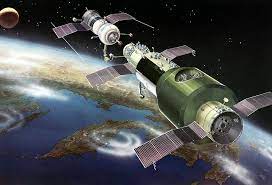Satellites have become an integral part of our daily lives, orbiting high above us and silently shaping the world we live in. From weather forecasting to global communication, these remarkable pieces of technology play a critical role in how we connect with one another and understand our planet. But how did it all begin? The story of satellites is filled with innovation, competition, and groundbreaking achievements that have transformed not just space exploration but also human civilization itself. As we delve into this fascinating journey—from early experiments to modern marvels—we’ll uncover the vital functions they serve today and explore what’s on the horizon for satellite technology. Prepare for an enlightening ride through time as we trace the evolution of these celestial wonders!
Early History of Satellite Development
The concept of satellites began as a dream, rooted in humanity’s desire to explore the unknown. In the early 20th century, pioneers like Konstantin Tsiolkovsky envisioned using rockets to reach space. Their ideas laid essential groundwork for what would follow.
The first real breakthrough came during World War II with advancements in rocket technology. German engineer Wernher von Braun played a significant role in this development. His work would later influence American satellite endeavors.
In 1957, Sputnik 1 made history as the world’s first artificial satellite. Launched by the Soviet Union, it sparked global fascination and competition between superpowers. This moment marked not just technological achievement but also political tension during the Cold War era.
As nations raced to establish their presence in space, experiments evolved into sophisticated projects that paved the way for today’s complex satellite systems. Each step forward brought new possibilities and challenges.
The Space Race and Advancements in Satellites
The Space Race was a fierce competition between the United States and the Soviet Union during the Cold War. It ignited immense interest in satellite technology, pushing both nations to innovate rapidly.
In 1957, the launch of Sputnik marked a monumental achievement. This first artificial satellite orbited Earth, sending beeping signals that captivated global attention. Suddenly, satellites were no longer just theoretical concepts but tangible realities.
The race continued with advancements like Explorer 1 and Luna 2. Each mission brought new discoveries about space and our planet. Scientists began to understand how satellites could gather data crucial for military intelligence and weather forecasting.
This intense rivalry fostered collaboration too; it laid groundwork for international partnerships in space exploration. As technology evolved, so did our understanding of how satellites could enhance daily life beyond mere observation or communication tasks.
Types of Satellites and Their Functions
Satellites come in various types, each designed for specific purposes. Communication satellites are among the most prevalent. They facilitate global telecommunications, enabling everything from phone calls to internet connectivity.
Next are weather satellites, crucial for monitoring atmospheric conditions. These devices provide vital data that helps predict storms and track climate change.
Earth observation satellites offer high-resolution imagery of our planet’s surface. They play a key role in agriculture, forestry management, and urban planning by supplying detailed information on land use.
Scientific research satellites contribute to our understanding of space and planetary systems. Equipped with advanced instruments, they gather invaluable data about celestial bodies and cosmic phenomena.
Navigation satellites form an integral part of GPS technology. They help guide vehicles worldwide, enhancing travel efficiency while ensuring safety on roads and seas.
Impact of Satellites on Modern Society
Satellites have woven themselves into the fabric of modern life. They enable global communication, allowing people to connect instantly across vast distances. Social media, video calls, and streaming services all rely on satellite technology.
Weather forecasting has dramatically improved thanks to satellites. Accurate data helps us prepare for natural disasters like hurricanes and floods, saving lives and protecting property.
In agriculture, farmers utilize satellite imagery to monitor crop health and optimize yields. This precision farming leads to more efficient resource use.
Additionally, satellites play a crucial role in navigation systems like GPS. These tools help millions find their way daily—whether driving or hiking in remote areas.
From enhancing security through surveillance to supporting scientific research from space, satellites continue transforming our world in profound ways. Their influence is felt in every corner of society, revolutionizing how we live and interact with one another.
Future of Satellite Technology
The future of satellite technology is poised for remarkable transformations. Innovations in miniaturization are leading to smaller, more efficient satellites. These tiny devices can be launched in swarms, enhancing communication and data collection capabilities.
Advancements in propulsion systems will allow satellites to maneuver with greater precision. This could revolutionize their ability to avoid space debris and operate longer without the need for costly refueling missions.
Moreover, artificial intelligence is set to play a crucial role. AI-powered satellites will analyze vast amounts of data autonomously, making real-time decisions that enhance our understanding of Earth’s environment.
As we look ahead, collaboration between countries and private enterprises will drive further progress. The expansion of global internet coverage via satellite constellations promises connectivity even in the most remote regions.
With efforts aimed at sustainability, future satellites may also focus on minimizing environmental impact while maximizing efficiency and functionality across various sectors.
Conclusion: The Revolutionary Impact of Satellites on Humanity
Satellites have undeniably transformed the way we interact with our world. They play a crucial role in communication, navigation, weather forecasting, and scientific research. From their early beginnings to sophisticated modern technologies, satellites have evolved tremendously.
The impact of these celestial machines reaches far beyond Earth’s atmosphere; they are essential for daily life and global connectivity. As technology progresses, the capabilities of satellites will only expand further.
Future innovations promise even greater advancements in satellite functionality and applications. The ongoing development in this field suggests that society has yet to realize the full potential of what satellites can offer.
As we move forward into an increasingly connected future, it is clear that satellites will continue to shape human experience significantly. Their influence touches every aspect of life on Earth and highlights humanity’s relentless pursuit of knowledge and exploration beyond our planet.

